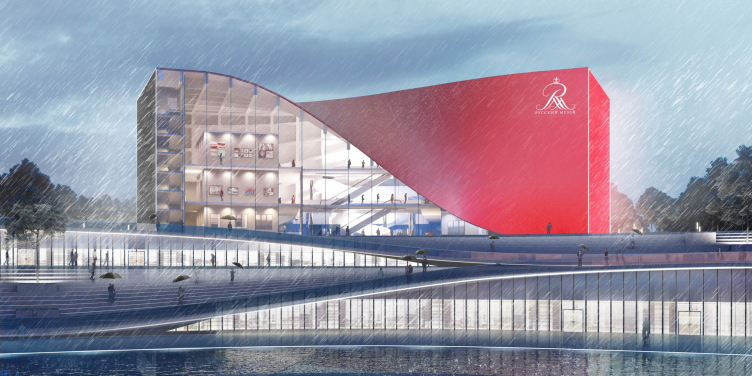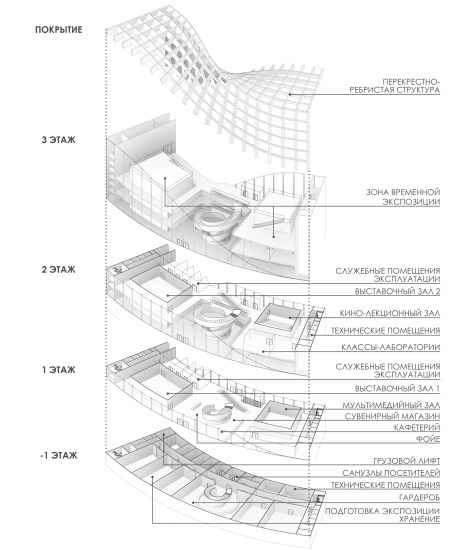The Kemerovo agglomeration got a name of “Siberian Cluster of Arts”. Its first stage, the educational one, is already being built in the Leninsky district, expanding the campus of the local higher educational institutions. The site of the museum and theater complexes is situated on the other side of town, on the bank of a small Iskitimka River, where public buildings are concentrated: a philharmonic hall, a few sports complexes, the Kemerovo State University and city administration, and, on the opposite side of this affluent of the Tom’, the new court building. After the construction of the museum buildings is completed and the Iskitimka banks are improved, an articulated central part of the city will be formed.
Originally, it was planned that separate dedicated buildings would be constructed for the branches of the Russian Museum, the Mariinsky Theater, and the Kuzbass Palace of Arts. Later, however, an idea came about to host these institutions under one roof – right about that time, the general designer was replaced, and the contractor too – now it was the Austrian company Coop Himmelb(l)au that has recently been actively engaged in working in Russia: they also authored the concept of the hockey arena built in the stead of Saint Petersburg Sports and Concert Complex and a cultural center for the Sevastopol cluster.
As a result of all these twists and turns, the PI ARENA project, developed for the branch of the Russian Museum, did not come to fruition, but managed to gain recognition from colleagues: in spring, its authors were awarded the silver medal of “Golden Section” festival. The commission to design a museum building, and not just any museum building, but such a high-profile one, and not encumbered by a historical context is an extraordinary piece of luck for an architectural company of any scale, which provides an opportunity to create, well, if not an iconic building, then something that goes far beyond the standard and pragmatic housing typology. This is why we could not miss such a project by the Russian architects, and wanted to see what they are about, when set free from the burden of the “economic performance indicators”.
The kemerovo branch of the Russian Museum. Master plan
Copyright: © PI ARENA
The kemerovo branch of the Russian Museum
Copyright: © PI ARENA
The first sketches by PI ARENA chiefly addressed the city context: according to the authors of the project, Kemerovo is a textbook example of Soviet architecture – its periods can be traced here like annual rings of a tree. However, the coworkers of the Russian Museum asked the architects to come up with an image that would easily identify the status of the building. Then the architects turned to the ideas of suprematism, building up the following logical passage: the museum hosts the biggest collection of Russian avant-garde paintings, whose best-known and recognizable representative is Kasimir Malevich, whose most ideologically charged work is, of course, “Black Square” that imbues the artist’s key ideas of the meaning of color and shape. In addition, the aesthetics of suprematism seems appropriate for the Soviet industrial city founded in 1918.
The kemerovo branch of the Russian Museum
Copyright: © PI ARENA
The basis for shape making was constituted by the principles of dynamic form and color, developed by Kasimir Malevich, and in this respect one could say that PI ARENA is indeed about a synthesis of architecture and painting. The volume of the building is a slightly bent cuboid that follows the line of the landscape, and was created by multiplying a flat square. The side walls are media screens that broadcast an image of a red and black square, as well as the information about the current exhibitions and events. The roof is composed of two bent triangles, which you can consider to be variations of another basic figure of suprematism – a cross of intersecting rectangles. Yet another primary figure, a circle, is situated inside of the building, and is a reference to Guggenheim museums.
The kemerovo branch of the Russian Museum. Form making
Copyright: © PI ARENA
The dynamic and sculptural character of the building is further enhanced by the “ribbons” of the roof – these ribbons are made of metallic panels, whose shade of color changes depending on the weather conditions, as well as the viewing angle. Wherever the ribbon detaches itself from the ground, as it was picked up by the wind, the observer can see the inner structure of the building, and in this diagonal, superimposed over the inner framework, one can discern an homage to another piece of museum classic – the Pompidou Center.
The kemerovo branch of the Russian Museum
Copyright: © PI ARENA
The kemerovo branch of the Russian Museum
Copyright: © PI ARENA
Despite the parametric shape, the building stays symmetrical. On the inside, it is composed of two wings of an approximately equal size: the exposition and the educational/research ones, between which a striking-looking spiral staircase is situated, which connects all the levels. All of the auxiliary rooms are situated in the underground floor, and the foyer is a pass-through one – one can enter the museum both from the side of the city and the embankment.
On the third floor level, the exposition wing has a dull white “box” – the perfect expo space, convenient both for curator ideas and for humidity-, temperature-, and light-sensitive works of art. From the outside, the “box” is surrounded by public and staff premises. The educational part has a similar structure and includes a video/lecture and a multimedia halls, auditoriums, and laboratories.
Working on a museum project is an important experience for any architectural company, and for ARENA, a company that is more known for projects of high-profile sports facilities, is one of the examples of broadening creative horizons. We will also note that the project was worked through as a real one ready for implementation. Of course, such companies as Coop Himmelb(l)au, are hard to compete with, but PI ARENA does have its strong sides: not claiming to create the “Bilbao effect” (which maybe will or maybe won’t take off in Kemerovo) it presents a meditation on the subject of the identity of the city founded in the XX century, and helps establish cultural ties between the regions situated thousands of miles apart.









































